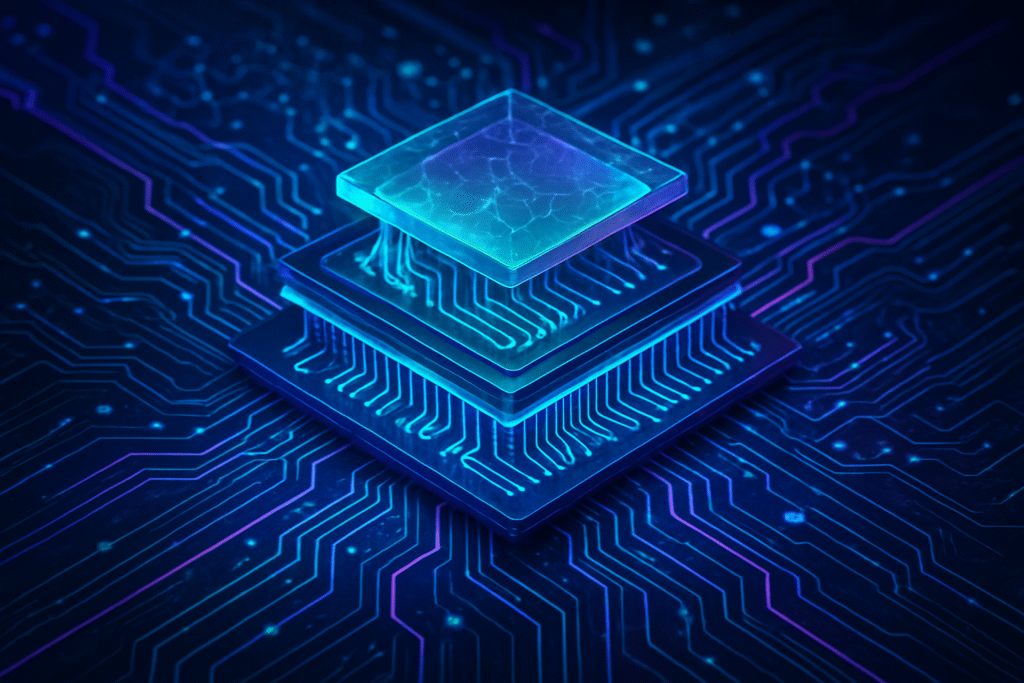
The foundational bedrock of the digital age, silicon, is encountering its inherent physical limits, prompting a monumental shift in the semiconductor industry. A new wave of materials and revolutionary chip architectures is emerging, promising to redefine the future of computing and propel artificial intelligence (AI) into unprecedented territories. This paradigm shift extends far beyond the advancements seen in wide bandgap (WBG) materials like silicon carbide (SiC) and gallium nitride (GaN), ushering in an era of ultra-efficient, high-performance, and highly specialized processing capabilities essential for the escalating demands of AI, high-performance computing (HPC), and pervasive edge intelligence.
This pivotal moment is driven by the relentless pursuit of greater computational power, energy efficiency, and miniaturization, all while confronting the economic and physical constraints of traditional silicon scaling. The innovations span novel two-dimensional (2D) materials, ferroelectrics, and ultra-wide bandgap (UWBG) semiconductors, coupled with groundbreaking architectural designs such as 3D chiplets, neuromorphic computing, in-memory processing, and photonic AI chips. These developments are not merely incremental improvements but represent a fundamental re-imagining of how data is processed, stored, and moved, promising to sustain technological progress well beyond the traditional confines of Moore's Law and power the next generation of AI-driven applications.
Technical Revolution: Unpacking the Next-Gen Chip Blueprint
The technical advancements pushing the semiconductor frontier are multifaceted, encompassing both revolutionary materials and ingenious architectural designs. At the material level, researchers are exploring Two-Dimensional (2D) Materials like graphene, molybdenum disulfide (MoS₂), and indium selenide (InSe). While graphene boasts exceptional electrical conductivity, its lack of an intrinsic bandgap has historically limited its direct use in digital switching. However, recent breakthroughs in fabricating semiconducting graphene on silicon carbide substrates are demonstrating useful bandgaps and electron mobilities ten times greater than silicon. MoS₂ and InSe, ultrathin at just a few atoms thick, offer superior electrostatic control, tunable bandgaps, and high carrier mobility, crucial for scaling transistors below the 10-nanometer mark where silicon faces insurmountable physical limitations. InSe, in particular, shows promise for up to a 50% reduction in power consumption compared to projected silicon performance.
Beyond 2D materials, Ferroelectric Materials are poised to revolutionize memory technology, especially for ultra-low power applications in both traditional and neuromorphic computing. By integrating ferroelectric capacitors (FeCAPs) with memristors, these materials enable highly efficient dual-use architectures for AI training and inference, which are critical for the development of ultra-low power edge AI devices. Furthermore, Ultra-Wide Bandgap (UWBG) Semiconductors such as diamond, gallium oxide (Ga₂O₃), and aluminum nitride (AlN) are being explored. These materials possess even larger bandgaps than current WBG materials, offering orders of magnitude improvement in figures of merit for power and radio frequency (RF) electronics, leading to higher operating voltages, switching frequencies, and significantly reduced losses, enabling more compact and lightweight system designs.
Complementing these material innovations are radical shifts in chip architecture. 3D Chip Architectures and Advanced Packaging (Chiplets) are moving away from monolithic processors. Instead, different functional blocks are manufactured separately—often using diverse, optimal processes—and then integrated into a single package. Techniques like 3D stacking and Intel's (NASDAQ: INTC) Foveros allow for increased density, performance, and flexibility, enabling heterogeneous designs where different components can be optimized for specific tasks. This modular approach is vital for high-performance computing (HPC) and AI accelerators. Neuromorphic Computing, inspired by the human brain, integrates memory and processing to minimize data movement, offering ultra-low power consumption and high-speed processing for complex AI tasks, making them ideal for embedded AI in IoT devices and robotics.
Furthermore, In-Memory Computing / Near-Memory Computing aims to overcome the "memory wall" bottleneck by performing computations directly within or very close to memory units, drastically increasing speed and reducing power consumption for data-intensive AI workloads. Photonic AI Chips / Silicon Photonics integrate optical components onto silicon, using light instead of electrons for signal processing. This offers potentially 1,000 times greater energy efficiency than traditional electronic GPUs for specific high-speed, low-power AI tasks, addressing the massive power consumption of modern data centers. While still nascent, Quantum Computing Architectures, with their hybrid quantum-classical designs and cryogenic CMOS chips, promise unparalleled processing power for intractable AI algorithms. Initial reactions from the AI research community and industry experts are largely enthusiastic, recognizing these advancements as indispensable for continuing the trajectory of technological progress in an era of increasingly complex and data-hungry AI.
Industry Ripples: Reshaping the AI Competitive Landscape
The advent of these advanced semiconductor technologies and novel chip architectures is poised to profoundly reshape the competitive landscape for AI companies, tech giants, and nimble startups alike. A discernible "AI chip arms race" is already underway, creating a foundational economic shift where superior hardware increasingly dictates AI capabilities and market leadership.
Tech giants, particularly hyperscale cloud providers, are at the forefront of this transformation, heavily investing in custom silicon development. Companies like Alphabet's Google (NASDAQ: GOOGL) with its Tensor Processing Units (TPUs) and Axion processors, Microsoft (NASDAQ: MSFT) with Maia 100 and Cobalt 100, Amazon (NASDAQ: AMZN) with Trainium and Inferentia, and Meta Platforms (NASDAQ: META) with MTIA are all designing Application-Specific Integrated Circuits (ASICs) optimized for their colossal cloud AI workloads. This strategic vertical integration reduces their reliance on external suppliers like NVIDIA (NASDAQ: NVDA), mitigates supply chain risks, and enables them to offer differentiated, highly efficient AI services. NVIDIA itself, with its dominant CUDA ecosystem and new Blackwell architecture, along with Taiwan Semiconductor Manufacturing Company (TSMC) (NYSE: TSM) and its technological leadership in advanced manufacturing processes (e.g., 2nm Gate-All-Around FETs and Extreme Ultraviolet lithography), continue to be primary beneficiaries and market leaders, setting the pace for innovation.
For AI companies, these advancements translate into enhanced performance and efficiency, enabling the development of more powerful and energy-efficient AI models. Specialized chips allow for faster training and inference, crucial for complex deep learning and real-time AI applications. The ability to diversify and customize hardware solutions for specific AI tasks—such as natural language processing or computer vision—will become a significant competitive differentiator. This scalability ensures that as AI models grow in complexity and data demands, the underlying hardware can keep pace without significant performance degradation, while also addressing environmental concerns through improved energy efficiency.
Startups, while facing the immense cost and complexity of developing chips on bleeding-edge process nodes (often exceeding $100 million for some designs), can still find significant opportunities. Cloud-based design tools and AI-driven Electronic Design Automation (EDA) are lowering barriers to entry, allowing smaller players to access advanced resources and accelerate chip development. This enables startups to focus on niche solutions, such as specialized AI accelerators for edge computing, neuromorphic computing, in-memory processing, or photonic AI chips, potentially disrupting established players with innovative, high-performance, and energy-efficient designs that can be brought to market faster. However, the high capital expenditure required for advanced chip development also risks consolidating power among companies with deeper pockets and strong foundry relationships. The industry is moving beyond general-purpose computing towards highly specialized designs optimized for AI workloads, challenging the dominance of traditional GPU providers and fostering an ecosystem of custom accelerators and open-source alternatives.
A New Foundation for the AI Supercycle: Broader Implications
The emergence of these advanced semiconductor technologies signifies a fundamental re-architecture of computing that extends far beyond mere incremental improvements. It represents a critical response to the escalating demands of the "AI Supercycle," particularly the insatiable computational and energy requirements of generative AI and large language models (LLMs). These innovations are not just supporting the current AI revolution but are laying the groundwork for its next generation, fitting squarely into the broader trend of specialized, energy-efficient, and highly parallelized computing.
One of the most profound impacts is the direct assault on the von Neumann bottleneck, the traditional architectural limitation where data movement between separate processing and memory units creates significant delays and consumes vast amounts of energy. Technologies like In-Memory Computing (IMC) and neuromorphic computing fundamentally bypass this bottleneck by integrating processing directly within or very close to memory, or by mimicking the brain's parallel, memory-centric processing. This architectural shift promises orders of magnitude improvements in both speed and energy efficiency, vital for training and deploying ever-larger and more complex AI models. Similarly, photonic chips, which use light instead of electricity for computation and data transfer, offer unprecedented speed and energy efficiency, drastically reducing the thermal footprint of data centers—a growing environmental concern.
The wider significance also lies in enabling pervasive Edge AI and IoT. The ultra-low power consumption and real-time processing capabilities of analog AI chips and neuromorphic systems are indispensable for deploying AI autonomously on devices ranging from smartphones and wearables to advanced robotics and autonomous vehicles. This decentralization of AI processing reduces latency, conserves bandwidth, and enhances privacy by keeping data local. Furthermore, the push for energy efficiency across these new materials and architectures is a crucial step towards more sustainable AI, addressing the substantial and growing electricity consumption of global computing infrastructure.
Compared to previous AI milestones, such as the development of deep learning or the transformer architecture, which were primarily algorithmic and software-driven, these semiconductor advancements represent a fundamental shift in hardware paradigms. While software breakthroughs showed what AI could achieve, these hardware innovations are determining how efficiently, scalably, and sustainably it can be achieved, and even what new kinds of AI can emerge. They are enabling new computational models that move beyond decades of traditional computing design, breaking physical limitations inherent in electrical signals, and redefining the possible for real-time, ultra-low power, and potentially quantum-enhanced AI. This symbiotic relationship, where AI's growth drives hardware innovation and hardware, in turn, unlocks new AI capabilities, is a hallmark of this era.
However, this transformative period is not without its concerns. Many of these technologies are still in nascent stages, facing significant challenges in manufacturability, reliability, and scaling. The integration of diverse new components, such as photonic and electronic elements, into existing systems, and the establishment of industry-wide standards, present complex hurdles. The software ecosystems for many emerging hardware types, particularly analog and neuromorphic chips, are still maturing, making programming and widespread adoption challenging. The immense R&D costs associated with designing and manufacturing advanced semiconductors also risk concentrating innovation among a few dominant players. Furthermore, while many technologies aim for efficiency, the manufacturing processes for advanced packaging, for instance, can be more energy-intensive, raising questions about the overall environmental footprint. As AI becomes more powerful and ubiquitous through these hardware advancements, ethical considerations surrounding privacy, bias, and potential misuse of AI technologies will become even more pressing.
The Horizon: Anticipating Future Developments and Applications
The trajectory of semiconductor innovation points towards a future where AI capabilities are continually amplified by breakthroughs in materials science and chip architectures. In the near term (1-5 years), we can expect significant advancements in the integration of 2D materials like graphene and MoS₂ into novel processing hardware, particularly through monolithic 3D integration that promises reduced processing time, power consumption, latency, and footprint for AI computing. Some 2D materials are already demonstrating the potential for up to a 50% reduction in power consumption compared to silicon's projected performance by 2037. Spintronics, leveraging electron spin, will become crucial for developing faster and more energy-efficient non-volatile memory systems, with breakthroughs in materials like thulium iron garnet (TmIG) films enabling greener magnetic random-access memory (MRAM) for data centers. Furthermore, specialized neuromorphic and analog AI accelerators will see wider deployment, bringing energy-efficient, localized AI to smart homes, industrial IoT, and personalized health applications, while silicon photonics will enhance on-chip communication for faster, more efficient AI chips in data centers.
Looking further into the long term (5+ years), the landscape becomes even more transformative. Continued research into 2D materials aims for full integration of all functional layers onto a single chip, leading to unprecedented compactness and efficiency. The vision of all-optical and analog optical computing will move closer to reality, eliminating electrical conversions for significantly reduced power consumption and higher bandwidth, enabling deep neural network computations entirely in the optical domain. Spintronics will further advance brain-inspired computing models, efficiently emulating neurons and synapses in hardware for spiking and convolutional neural networks with novel data storage and processing. While nascent, the integration of quantum computing with semiconductors will progress, with hybrid quantum-classical architectures tackling complex AI algorithms beyond classical capabilities. Alongside these, novel memory technologies like resistive random-access memory (RRAM) and phase-change memory (PCM) will become pivotal for advanced neuromorphic and in-memory computing systems.
These advancements will unlock a plethora of potential applications. Ultra-low-power Edge AI will become ubiquitous, enabling real-time, local processing on smartphones, IoT sensors, autonomous vehicles, and wearables without constant cloud connectivity. High-Performance Computing and Data Centers will see their colossal energy demands significantly reduced by faster, more energy-efficient memory and optical processing, accelerating training and inference for even the most complex generative AI models. Neuromorphic and bio-inspired AI systems, powered by spintronic and 2D material chips, will mimic the human brain's efficiency for complex pattern recognition and unsupervised learning. Advanced robotics, autonomous systems, and even scientific discovery in fields like astronomy and personalized medicine will be supercharged by the massive computational power these technologies afford.
However, significant challenges remain. The integration complexity of novel optical, 2D, and spintronic components with existing electronic hardware poses formidable technical hurdles. Manufacturing costs and scalability for cutting-edge semiconductor processes remain high, requiring substantial investment. Material science and fabrication techniques for novel materials need further refinement to ensure reliability and quality control. Balancing the drive for energy efficiency with the ever-increasing demand for computational power is a constant tightrope walk. A lack of standardization and ecosystem development could hinder widespread adoption, while the persistent global talent shortage in the semiconductor industry could impede progress. Finally, efficient thermal management will remain critical as devices become even more densely integrated.
Expert predictions paint a future where AI and semiconductor innovation share a symbiotic relationship. AI will not just consume advanced chips but will actively participate in their creation, optimizing design, layout, and quality control, accelerating the innovation cycle itself. The focus will shift from raw performance to application-specific efficiency, driving the development of highly customized chips for diverse AI workloads. Memory innovation, including High Bandwidth Memory (HBM) and next-generation DRAM alongside novel spintronic and 2D material-based solutions, will continue to meet AI's insatiable data hunger. Experts foresee ubiquitous Edge AI becoming pervasive, making AI more accessible and scalable across industries. The global AI chip market is projected to surpass $150 billion in 2025 and could reach an astonishing $1.3 trillion by 2030, underscoring the profound economic impact. Ultimately, sustainability will emerge as a key driving force, pushing the industry towards energy-efficient designs, novel materials, and refined manufacturing processes to reduce the environmental footprint of AI. The co-optimization across the entire hardware-software stack will become crucial, marking a new era of integrated innovation.
The Next Frontier: A Hardware Renaissance for AI
The semiconductor industry is currently undergoing a profound and unprecedented transformation, driven by the escalating computational demands of artificial intelligence. This "hardware renaissance" extends far beyond the traditional confines of silicon scaling and even established wide bandgap materials, embracing novel materials, advanced packaging techniques, and entirely new computing paradigms to deliver the speed, energy efficiency, and scalability required by modern AI.
Key takeaways from this evolution include the definitive move into a post-silicon era, where the physical and economic limitations of traditional silicon are being overcome by new materials like 2D semiconductors, ferroelectrics, and advanced UWBG materials. Efficiency is paramount, with the primary motivations for these emerging technologies centered on achieving unprecedented power and energy efficiency, particularly crucial for the training and inference of large AI models. A central focus is the memory-compute convergence, aiming to overcome the "memory wall" bottleneck through innovations in in-memory computing and neuromorphic designs that tightly integrate processing and data storage. This is complemented by modular and heterogeneous design facilitated by advanced packaging techniques, allowing diverse, specialized components (chiplets) to be integrated into single, high-performance packages.
This period represents a pivotal moment in AI history, fundamentally redefining the capabilities and potential of Artificial Intelligence. These advancements are not merely incremental; they are enabling a new class of AI hardware capable of processing vast datasets with unparalleled efficiency, unlocking novel computing paradigms, and accelerating AI development from hyperscale data centers to the furthest edge devices. The immediate significance lies in overcoming the physical limitations that have begun to constrain traditional silicon-based chips, ensuring that the exponential growth of AI can continue unabated. This era signifies that AI has transitioned from largely theoretical research into an age of massive practical deployment, demanding a commensurate leap in computational infrastructure. Furthermore, AI itself is becoming a symbiotic partner in this evolution, actively participating in optimizing chip design, layout, and manufacturing processes, creating an "AI supercycle" where AI consumes advanced chips and also aids in their creation.
The long-term impact of these emerging semiconductor technologies on AI will be transformative and far-reaching, paving the way for ubiquitous AI seamlessly integrated into every facet of daily life and industry. This will contribute to sustained economic growth, with AI projected to add approximately $13 trillion to the global economy by 2030. The shift towards brain-inspired computing, in-memory processing, and optical computing could fundamentally redefine computational power, energy efficiency, and problem-solving capabilities, pushing the boundaries of what AI can achieve. Crucially, these more efficient materials and computing paradigms will be vital in addressing the sustainability imperative as AI's energy footprint continues to grow. Finally, the pursuit of novel materials and domestic semiconductor supply chains will continue to shape the geopolitical landscape, impacting global leadership in technology.
In the coming weeks and months, industry watchers should keenly observe announcements from major chip manufacturers like Intel (NASDAQ: INTC), Advanced Micro Devices (NASDAQ: AMD), and NVIDIA (NASDAQ: NVDA) regarding their next-generation AI accelerators and product roadmaps, which will showcase the integration of these emerging technologies. Keep an eye on new strategic partnerships and investments between AI developers, research institutions, and semiconductor foundries, particularly those aimed at scaling novel material production and advanced packaging capabilities. Breakthroughs in manufacturing 2D semiconductor materials at scale for commercial integration could signal the true dawn of a "post-silicon era." Additionally, follow developments in neuromorphic and in-memory computing prototypes as they move from laboratories towards real-world applications, with in-memory chips anticipated for broader use within three to five years. Finally, observe how AI algorithms themselves are increasingly utilized to accelerate the discovery and design of new semiconductor materials, creating a virtuous cycle of innovation that promises to redefine the future of computing.
This content is intended for informational purposes only and represents analysis of current AI developments.
TokenRing AI delivers enterprise-grade solutions for multi-agent AI workflow orchestration, AI-powered development tools, and seamless remote collaboration platforms.
For more information, visit https://www.tokenring.ai/.





